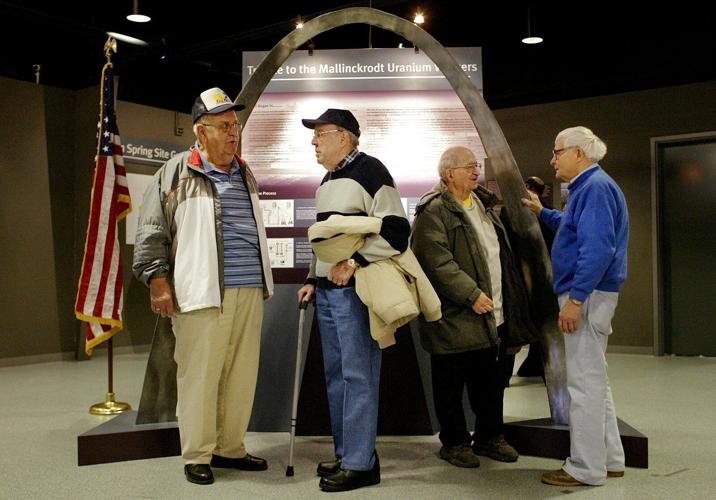Denise Brock remembers when she got the call from the Department of Energy.
The federal government had just built a beautiful new building for the , a museum of the countryŌĆÖs nuclear age and its deep connections to ūŅą┬ąė░╔įŁ┤┤. The museum is built on a hill in St. Charles County, not far from the Missouri River. It is adjacent to a massive pile of gray rock and rubble, under which are buried the byproducts of uranium processing that Mallinckrodt Chemical workers performed during the Cold War.
Many of those iron workers and their family members became sick with various ailments later in life. One of them was BrockŌĆÖs father. For much of her adult life, she was one of the driving forces behind the , which has paid out billions of dollars to the workers and families who gave so much to AmericaŌĆÖs nuclear age.
People are also reading…
Brock and others advocated for a memorial to those workers in the original interpretive center. The fancy new building didnŌĆÖt have room for it, a DOE employee told her in the phone call a couple of years ago. They wanted to know if she would come retrieve it.
ŌĆ£I was so devastated,ŌĆØ she says. ŌĆ£The fact that they were not going to include it in the new center absolutely broke me.ŌĆØ
Brock did what she does best. She rallied the troops. Tony West, a documentarian, and the Rev. Gerry Kleba, a Catholic priest, started burning up the phone lines. One of those calls came to me. Not long after I visited the interpretive center and was denied an opportunity to see the old memorial, the DOE changed its mind. Good for them.
That memorial, dedicated to the men and women who lost their lives during the nuclear arms race, has been placed in the new center. On Sunday at 2 p.m., it will be rededicated. If youŌĆÖve never been to the interpretive center, itŌĆÖs worth a visit this weekend.

Denise Brock poses for a picture next to the Weldon Spring uranium disposal area on Feb. 19, 2012.
ŌĆ£The uranium workers may not have been on the battlefield or laying in trenches, but they certainly served this nation,ŌĆØ Brock says. ŌĆ£And many of those workers paid a very high price for their service, developing disabling and often fatal illnesses.ŌĆØ
History can be a funny thing. Memories fade over time.
When Brock and the iron workers dedicated the memorial in 2004, there was great fanfare, with two U.S. senators, congressmen and other dignitaries in attendance. But those elected officials are no longer in power. Federal bureaucrats come and go, people forget. But uranium lives forever. And the issues that come with ūŅą┬ąė░╔įŁ┤┤ŌĆÖ role in uranium enrichment, from the Manhattan Project to the Cold War, havenŌĆÖt gone away.
Witness the ongoing dispute over Jana Elementary School in Florissant. It was closed permanently last fall by the Hazelwood School District after a report by a private company showed ŌĆ£high levelsŌĆØ of radioactive activity at the school and its playground. The school sits in the flood plain of Coldwater Creek, which was contaminated with radioactive materials as far back as the 1940s.
U.S. Sen. Josh Hawley, a Republican, and U.S. Rep. Cori Bush, a Democrat, have filed ŌĆ£Justice for JanaŌĆØ legislation calling for federal testing for radioactive waste at all Hazelwood school buildings, as well as funding for new construction.

From left, Mark Bruening, 77, of O'Fallon; Donald Moreland, 80, of Bellefontaine Neighbors; Mel Makara, 78, of Cuba; and John Bognar, 76, of Moscow Mills, share stories of their days as Mallinckrodt workers on Nov. 29, 2005. A monument honoring former employees at the Weldon Spring Interpretive Center was unveiled that day.
This comes even as the federal government downplays the risk, saying its own testing shows Jana Elementary is safe to use.
ŌĆ£Our government created this waste to construct the most deadly nuclear weapon in history,ŌĆØ Bush said in a news release last month. ŌĆ£They have a responsibility to clean it up and ensure that the safety and well-being of our community is a top priority.ŌĆØ
The history is told through artifacts and other displays at the modern steel-and-glass museum sitting next to the highest point in St. Charles County. Some of that history at the Weldon Spring Interpretive Center is patriotic. Some of it tells a more complicated story of moral failure, of death and destruction, and of workers being exposed to unknown dangers.
Now that BrockŌĆÖs memorial to workers is back, the museumŌĆÖs story is more complete, as it should be.
The reality is that ūŅą┬ąė░╔įŁ┤┤ŌĆÖ connection to the Cold War is tinged with race, secrecy and death. If youŌĆÖve ever been to environmentalist Kay DreyŌĆÖs basement, where she has a trove of documents and research on the topic, you get an understanding of the deep connections to this cityŌĆÖs past.
HereŌĆÖs how ūŅą┬ąė░╔įŁ┤┤ author Linda C. Morice described that history in her recent book, :
ŌĆ£Aside from the actual loss of my parents and brother, the most painful part of my association with Coldwater Creek is revising the warm recollections of childhood to accommodate a grim reality,ŌĆØ Morice, who grew up in Florissant, wrote. ŌĆ£As a former U.S. history teacher, it is also unsettling to acknowledge the likelihood that my loved onesŌĆÖ deaths were part of the cost of World War II.ŌĆØ














